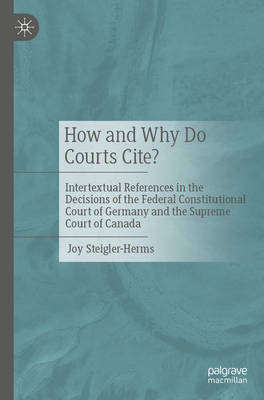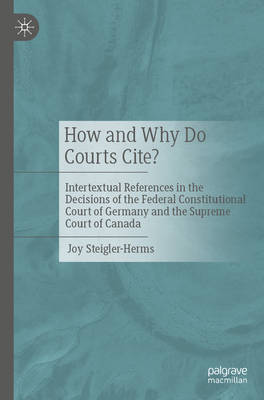
- Retrait gratuit dans votre magasin Club
- 7.000.000 titres dans notre catalogue
- Payer en toute sécurité
- Toujours un magasin près de chez vous
- Retrait gratuit dans votre magasin Club
- 7.000.0000 titres dans notre catalogue
- Payer en toute sécurité
- Toujours un magasin près de chez vous
How and Why Do Courts Cite?
Intertextual References in the Decisions of the Federal Constitutional Court of Germany and the Supreme Court of Canada
Joy Steigler-HermsDescription
Court decisions can neither be made nor drafted without references to other texts; citations are omnipresent in judicial rulings. Every decision takes relevant normative texts or precedents into account, primarily to ensure coherent case law. Through the act of referencing, courts demonstrate that their decisions are based on an established legal doctrine. This integration into the existing doctrine legitimizes the decision and thus creates legal certainty through predictability.
Moreover, court decisions also contain references to texts that do not possess legal authority and therefore cannot be assigned such a function. Among the sources cited by courts, alongside statutory texts, are--for example--references to foreign law, scholarly sources, or even literary texts.
In view of this, the present study addresses the question of how and why courts cite. Using decisions from the Federal Constitutional Court of Germany and the Supreme Court of Canada as examples, the interdisciplinary study proposes both philological and legal evaluation criteria for the empirical reconstruction of citation functions and furthermore adopts a comparative perspective on jurisdiction-related differences in citation practices in courts.
Spécifications
Parties prenantes
- Auteur(s) :
- Editeur:
Contenu
- Nombre de pages :
- 216
- Langue:
- Anglais
Caractéristiques
- EAN:
- 9783662719336
- Date de parution :
- 13-11-25
- Format:
- Livre broché
- Format numérique:
- Trade paperback (VS)
- Dimensions :
- 155 mm x 235 mm

Les avis
Nous publions uniquement les avis qui respectent les conditions requises. Consultez nos conditions pour les avis.






